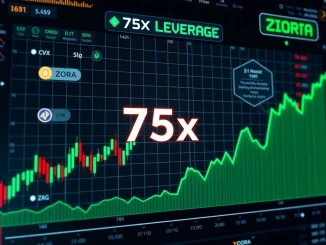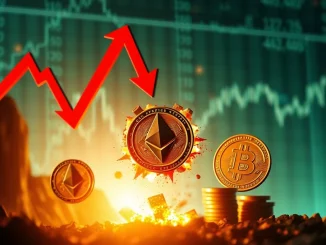
Crypto watchers were alerted to a significant on-chain movement involving a substantial amount of Ethereum (ETH). A wallet address, previously dormant for three years, suddenly became active, depositing a considerable sum into a major decentralized finance (DeFi) protocol. This kind of activity often signals potential shifts or strategies from large holders, commonly referred to as ‘whales’.
A Major Ethereum Move: $35.46M Deposit
According to on-chain data shared by The Data Nerd on X, an address beginning with 0x955a recently moved 20,000 ETH. At the time of the transaction, this amounted to approximately $35.46 million. The notable aspect? This address had been inactive for a prolonged period of three years before executing this large deposit.
Here’s a quick breakdown of the key details:
- Asset Moved: 20,000 ETH
- Value at Time of Deposit: ~$35.46 million
- Destination: Aave protocol
- Previous Activity: Dormant for 3 years
- Source of Information: The Data Nerd (on-chain analytics)
Who is Behind the Consensys Link?
The intrigue around this transaction intensified due to the address’s presumed connection to Russell Verbeeten, reportedly the Managing Director at Consensys Canada. While on-chain data provides transparency regarding transactions, linking addresses definitively to specific individuals or entities often relies on circumstantial evidence or previously known associations. The speculation suggests a potential high-profile figure within the Consensys ecosystem is behind this move, adding weight to its significance.
Understanding the Aave Protocol
For those new to DeFi, Aave is one of the largest decentralized lending and borrowing protocols. It allows users to deposit cryptocurrencies as collateral to earn yield or to borrow other cryptocurrencies. Deposits like this large ETH sum contribute to the protocol’s liquidity pool, enabling more borrowing activity and potentially generating passive income for the depositor through lending yields.
Key aspects of Aave:
- Decentralized (runs on blockchain)
- Lending and borrowing platform
- Users deposit crypto to earn interest
- Users can borrow crypto against collateral
- Governance is managed by token holders (AAVE)
Why Deposit ETH into Aave?
A deposit of this magnitude into Aave, especially after a long dormancy period, could indicate several potential strategies:
- Earning Yield: The simplest reason is to earn passive income on the large ETH holding by lending it out through the protocol.
- Borrowing Opportunity: The deposited ETH could be used as collateral to borrow other assets without selling the original ETH position. This is often done for leverage, shorting, or accessing stablecoins for other investments or operational needs.
- Testing the Waters: After a period of inactivity, a large deposit could be a precursor to further on-chain activity or a strategic allocation of previously static assets.
- Diversification/Risk Management: Utilizing DeFi protocols can be part of a broader strategy for managing digital assets.
Potential Implications and Market Watch
While a single large deposit doesn’t necessarily dictate market direction, significant moves by presumed whales, especially those linked to prominent industry figures like those at Consensys, are closely watched. This deposit into Aave could signal a strategic engagement with the DeFi ecosystem, potentially influencing sentiment or indicating future moves related to lending, borrowing, or other protocol interactions involving this large ETH position.
It highlights the increasing integration of even large, long-term holders with DeFi platforms, seeking yield or leverage opportunities on their assets rather than letting them sit idle in wallets.
Summary: A Whale Re-Engages with DeFi
The deposit of 20,000 ETH ($35.46 million) into Aave from an address dormant for three years, and potentially linked to a Consensys Canada executive, is a noteworthy event in the crypto space. It demonstrates a large-scale re-engagement with the DeFi ecosystem, likely aimed at generating yield or enabling borrowing activities. As the Ethereum network and its associated DeFi protocols continue to evolve, observing the movements of such significant addresses provides valuable insight into potential strategies and confidence levels among major market participants.



